Evolution Characteristics of Overburden Strata Structure for Ultra-Thick Coal Seam Multi-Layer Mining in Xinjiang East Junggar Basin
Abstract
1. Introduction
- (1)
- The stress redistribution within the overburden strata and the associated strata instability characteristics induced by ultra-thick coal seam mining based on practical experience. Jeromel et al. [9] and Jakob et al. [10] studied the stress redistribution characteristics in multi-slice longwall top coal caving and quantified the vertical stress under different mining retreat speed and at varying mining layer thicknesses, which has been successfully used for the determination of reasonable mining parameters in ultra-thick coal seam mining. Islam et al. [11] examined the stress redistribution law and the strata failure characteristics under different rock mechanics parameters and total mining thicknesses in the multi-slice mining of ultra-thick coal seams, and concluded that the stress redistribution induced by ultra-thick coal seam extraction can result in the deformation of the geological structure, leading to the fracture network development as groundwater flow pathways. Deng et al. [12] studied the roof displacement and vertical stress changes during the upward mining of ultra-thick coal seam with backfilling. It was found that the overburden subsidence and the vertical stress gradually decreased with the increase of the number of mining layers as the extraction of the first seam has greater impact on the stability of the surrounding rock. Zarlin et al. [13,14] studied the vertical displacement and elasto-plastic zone distribution characteristics of the surrounding strata, using multi-slice room and pillar methods for ultra-thick coal seam mining. They suggested that when the coal seam is relatively weak, the multi-slice room and pillar methods can effectively control the surface subsidence.
- (2)
- The characteristics of overburden strata and the ground control techniques for thick and competent roof strata in thick seam mining. Kang et al. [15] analyzed the characteristics of mining-induced fracture propagation in the repeated mining of thick coal seam and proposed the prediction method for the “two zones” height within the overburden, summarizing the relationship between the crack height of overburden and the seam thickness. They concluded that the increase of seam extraction layers can improve the roof control. Zhang et al. [16] studied the main characteristics of the multi-seam mining fissure field and found that the overburden failure zone of the cover rock at the coal face is shown to be saddle-like in shape, high on both sides and low at the middle, the number and width of small cracks increases with continued mining. Zhu et al. [17] analyzed overburden movement characteristics of top-coal caving mining in multi-seam areas by simulation experiment and microseismic monitoring. It is believed that coal pillars left over from upper coal seam would cause further development of overburden fractures, and that design of small coal pillars and hydraulic fracturing should be used to improve overburden stress environment. Xu et al. [18] studied the characteristics of overlying strata instability under the multi-layer mining of ultra-thick coal seam using physical modelling. It is believed that the increase of mining volume is likely to cause large-scale instability of the overlying strata, and the fracture development is mainly controlled by the key strata structure. Yu et al. [19,20] and Wang W. et al. [21] focused on the strong mine pressure in thick coal seam mining based on cases studies in Datong Mine, and revealed the relationship between the height of fracture zone in the overburden and the seam thickness. They established an empirical model for the overlying strata movements in the caving of ultra-thick coal seam; and developed an effective roof control strategy combining the use of hydraulic fracturing [22] from surface drilling and pre-conditioning of roof strata.
2. Geological Condition at East Junggar Coalfield
3. Overview of the Methodology
3.1. Physical Model Setup
3.2. Numerical Model Setup
3.3. The Failure Features of Overburden
3.3.1. Strata Failure Process
3.3.2. The Secondary Break
3.4. The Structural Evolution of the Overburden Strata
3.5. Mechanisms Contributing to the Change of the Overburden Structure
3.5.1. Stress Redistribution Characteristics in the Roof
3.5.2. Beam structure stability analysis
4. Interactions between Shields and Surrounding Rock Mass
4.1. The Interaction at Early Stage
4.2. The Interaction at Later Stage
5. Conclusions
Author Contributions
Funding
Acknowledgments
Conflicts of Interest
References
- Song, H.Z. Chinese Coal Resources Distribution and Future Exploration; China University of Geosciences: Beijing, China, 2013. (In Chinese) [Google Scholar]
- Jerrett, R.M.; Davies, R.C.; Hodgson, D.M.; Flint, S.S.; Chicerrell, R.C. The significance of hiatal surfaces in coal seams. J. Geol. Soc. 2011, 168, 629–632. [Google Scholar] [CrossRef]
- Likar, J.; Dervaric, E.; Medved, M.; Cadez, J.; Jeromel, G. Some methods of analyzing caving processes in sublevel coal mining. RMZ Mater. Geoenviron. 2006, 53, 203–220. [Google Scholar]
- Ren, F.H.; Lai, X.P.; Cai, M.F. Dynamic destabilization analysis based on AE experiment of deep-seated, steep-inclined and extra-thick coal seam. J. Univ. Sci. Technol. Beijing Miner. Met. Mater. 2008, 15, 215–219. [Google Scholar] [CrossRef]
- Unver, B.; Yasitli, N.E. Modelling of strata movement with a special reference to caving mechanism in thick seam coal mining. Int. J. Coal Geol. 2006, 66, 227–252. [Google Scholar] [CrossRef]
- Wang, J.H.; Yu, B.; Kang, H.P.; Wang, G.F.; Mao, D.B.; Liang, Y.T.; Jiang, P.F. Key technologies and equipment for a fully mechanized top-coal caving operation with a large mining height at ultra-thick coal seams. Int. J. Coal Sci. Technol. 2015, 2, 97–161. [Google Scholar] [CrossRef]
- Si, G.Y.; Jamnikar, S.; Lazar, J.; Shi, J.Q.; Durucan, S.; Korre, A.; Zavsek, S. Monitoring and modelling of gas dynamics in multi-level longwall top coal caving of ultra-thick coal seams, part I: Borehole measurements and a conceptual model for gas emission zones. Int. J. Coal Geol. 2015, 144, 98–110. [Google Scholar] [CrossRef]
- Si, G.Y.; Shi, J.Q.; Durucan, S.; Korre, A.; Lazar, J.; Jamnikar, S.; Zavsek, S. Monitoring and modelling of gas dynamics in multi-level longwall top coal caving of ultra-thick coal seams, Part II: Numerical modelling. Int. J. Coal Geol. 2015, 144–145, 58–70. [Google Scholar] [CrossRef]
- Jeromel, G.; Medved, M.; Likar, J. An analysis of the geomechanical processes in coal mining using the Velenje mining method. Acta Geotech. Slov. 2010, 7, 30–45. [Google Scholar]
- Likar, J.; Medved, M.; Lenart, M.; Mayer, J.; Malenković, V.; Jeromel, G.; Dervarič, E. Analysis of geomechanical changes in hanging wall caused by longwall multi top caving in coal mining. J. Min. Sci. 2012, 48, 135–145. [Google Scholar] [CrossRef]
- Islam, M.R.; Hayashi, D.; Kamruzzaman, A.B.M. Finite element modeling of stress distributions and problems for multi-slice longwall mining in Bangladesh, with special reference to the Barapukuria coal mine. Int. J. Coal Geol. 2009, 78, 91–109. [Google Scholar] [CrossRef]
- Deng, X.J.; Zhang, J.X.; Kang, T.; Han, X.L. Strata behavior in extra-thick coal seam mining with upward slicing backfilling technology. Int. J. Min. Sci. Technol. 2016, 26, 587–592. [Google Scholar] [CrossRef]
- Lin, N.; Sasaoka, T.; Shimada, H.; Matsui, K. Numerical study on an applicable underground mining method for soft extra-thick coal seams in Thailand. Engineering 2012, 4, 739–745. [Google Scholar]
- Lin, N.; Sasaoka, T.; Shimada, H.; Hamanaka, A.; Matsui, K. Numerical analysis of interaction effects in double extra-thick coal seams mining. Procedia Earth Planet. Sci. 2013, 6, 343–349. [Google Scholar] [CrossRef]
- Kang, Y.; Huang, F.; Xi, J. Overburden failure patterns under repeated mining. Coal Sci. Technol. 2001, 29, 22–24. (In Chinese) [Google Scholar]
- Zhang, D.M.; Qi, X.H.; Yin, G.Z.; Zheng, B.B. Coal and rock fissure evolution and distribution characteristics of multi-seam mining. Int. J. Min. Sci. Technol. 2013, 23, 835–840. [Google Scholar] [CrossRef]
- Zhu, Z.J.; Zhang, H.W.; Nemcik, J.; Lan, T.W.; Han, J.; Chen, Y. Overburden movement characteristics of top-coal caving mining in multi-seam areas. Q. J. Eng. Geol. Hydrogeol. 2018, 51, 276–286. [Google Scholar] [CrossRef]
- Xu, M.T.; Zhang, W.; Wang, Z.K.; Xiao, L.P. Physical simulation test for movement laws of overlying strata in extra-thick coal seam mining. Electron. J. Geotech. Eng. 2014, 13, 9425–9438. [Google Scholar]
- Yu, B. Behaviors of overlying strata in extra-thick coal seams using top-coal caving method. J. Rock Mech. Geotech. Eng. 2016, 8, 238–247. [Google Scholar] [CrossRef]
- Yu, B.; Zhao, J.; Kuang, T.J.; Meng, X.B. In situ investigations into overburden failures of a super-thick coal seam for longwall top coal caving. Int. J. Rock Mech. Min. Sci. 2015, 78, 155–162. [Google Scholar] [CrossRef]
- Wang, W.; Cheng, Y.P.; Wang, H.F.; Liu, H.Y.; Wang, L.; Li, W.; Jiang, J.Y. Fracture failure analysis of hard–thick sandstone roof and its controlling effect on gas emission in underground ultra-thick coal extraction. Eng. Fail. Anal. 2015, 54, 150–162. [Google Scholar] [CrossRef]
- Huang, B.X.; Yu, B.; Feng, F.; Li, Z.; Wang, Y.Z.; Liu, J.R. Field investigation into directional hydraulic fracturing for hard roof in Tashan Coal Mine. J. Coal Sci. Eng. (China) 2013, 19, 153–159. [Google Scholar] [CrossRef]


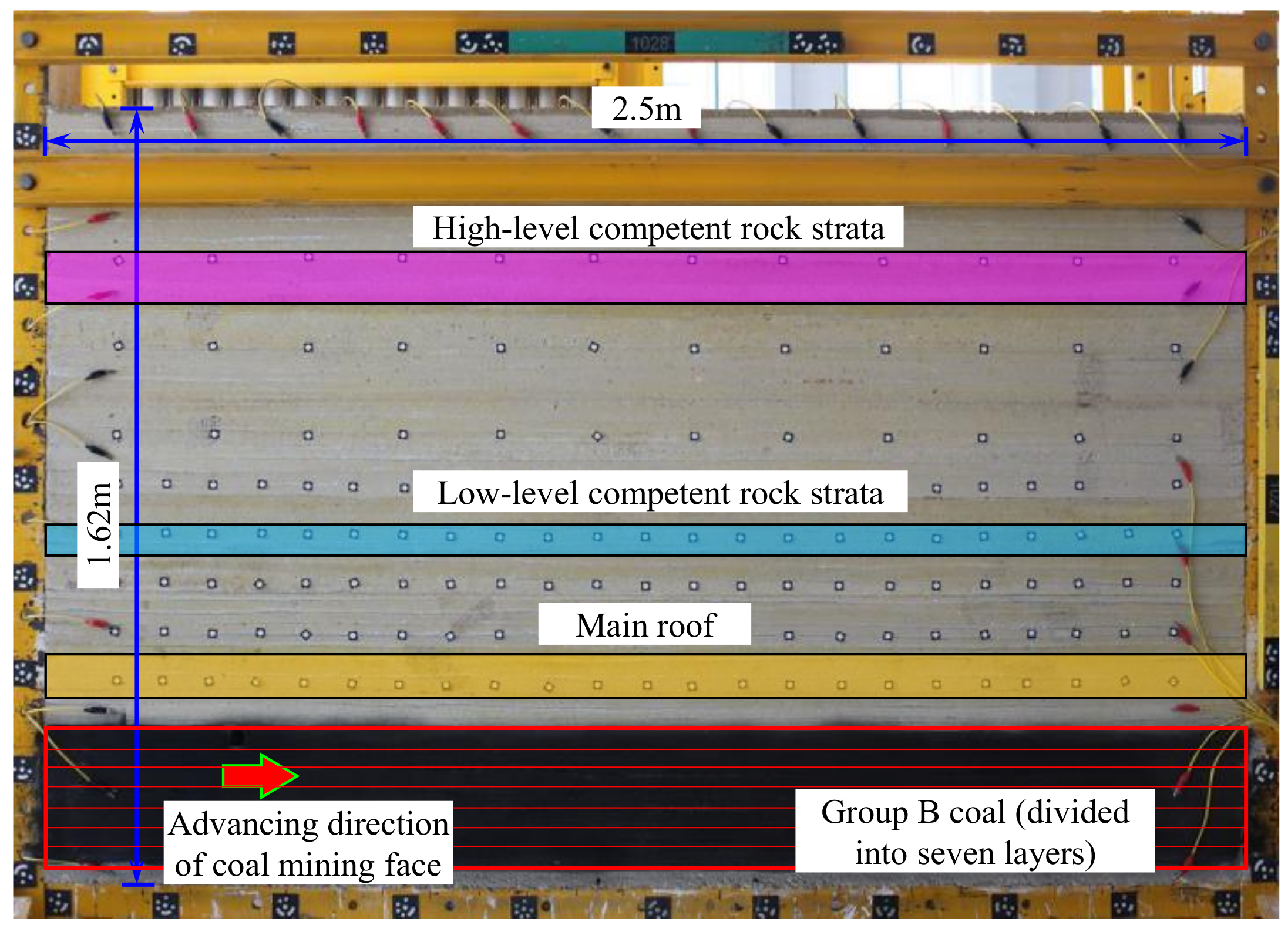

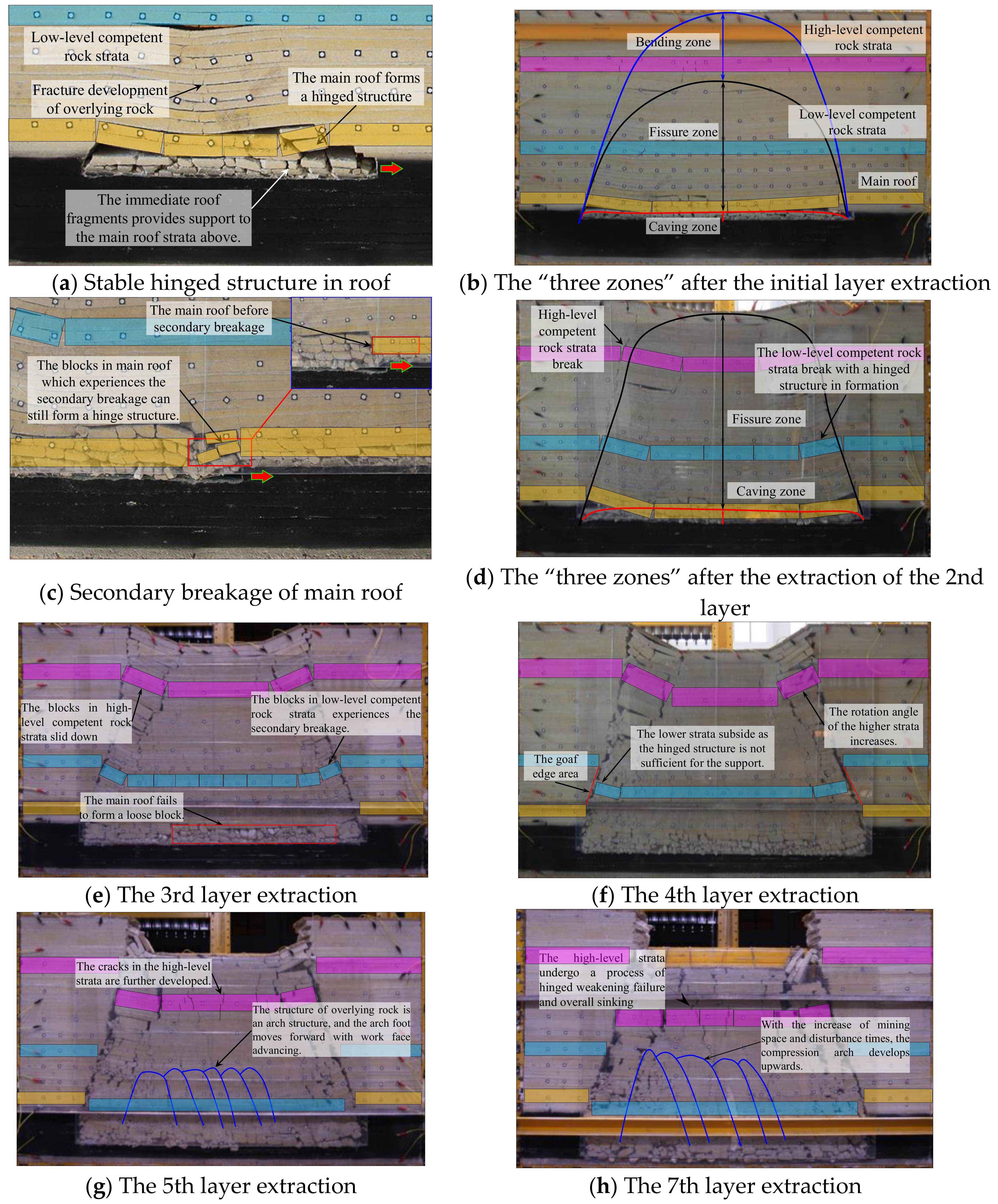


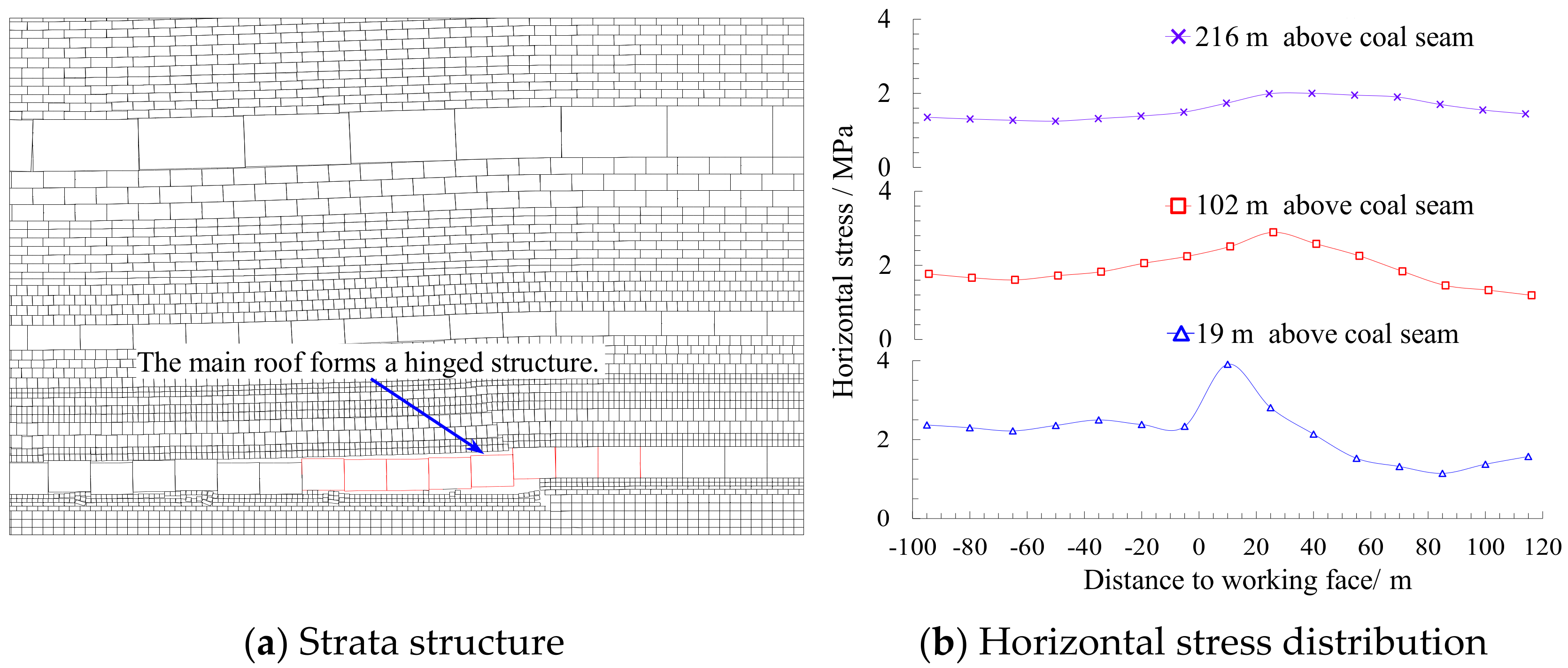
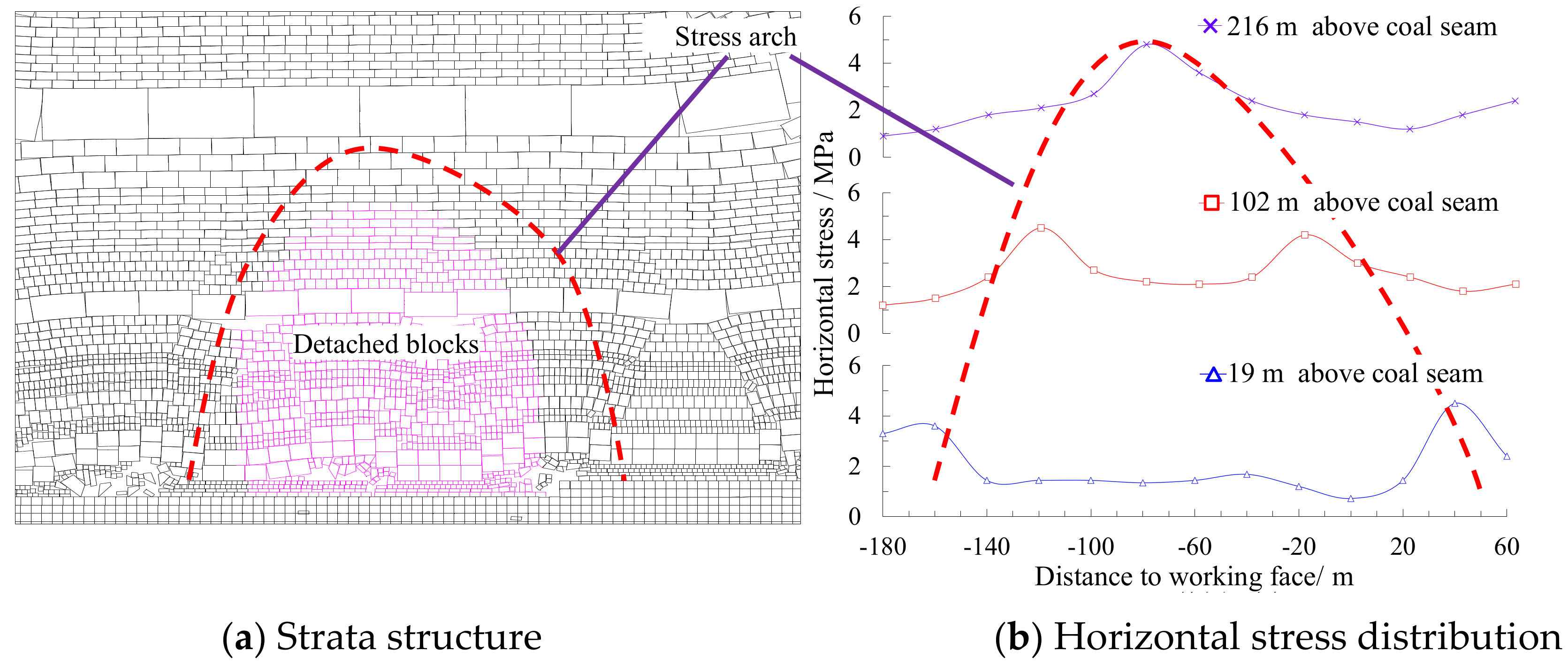
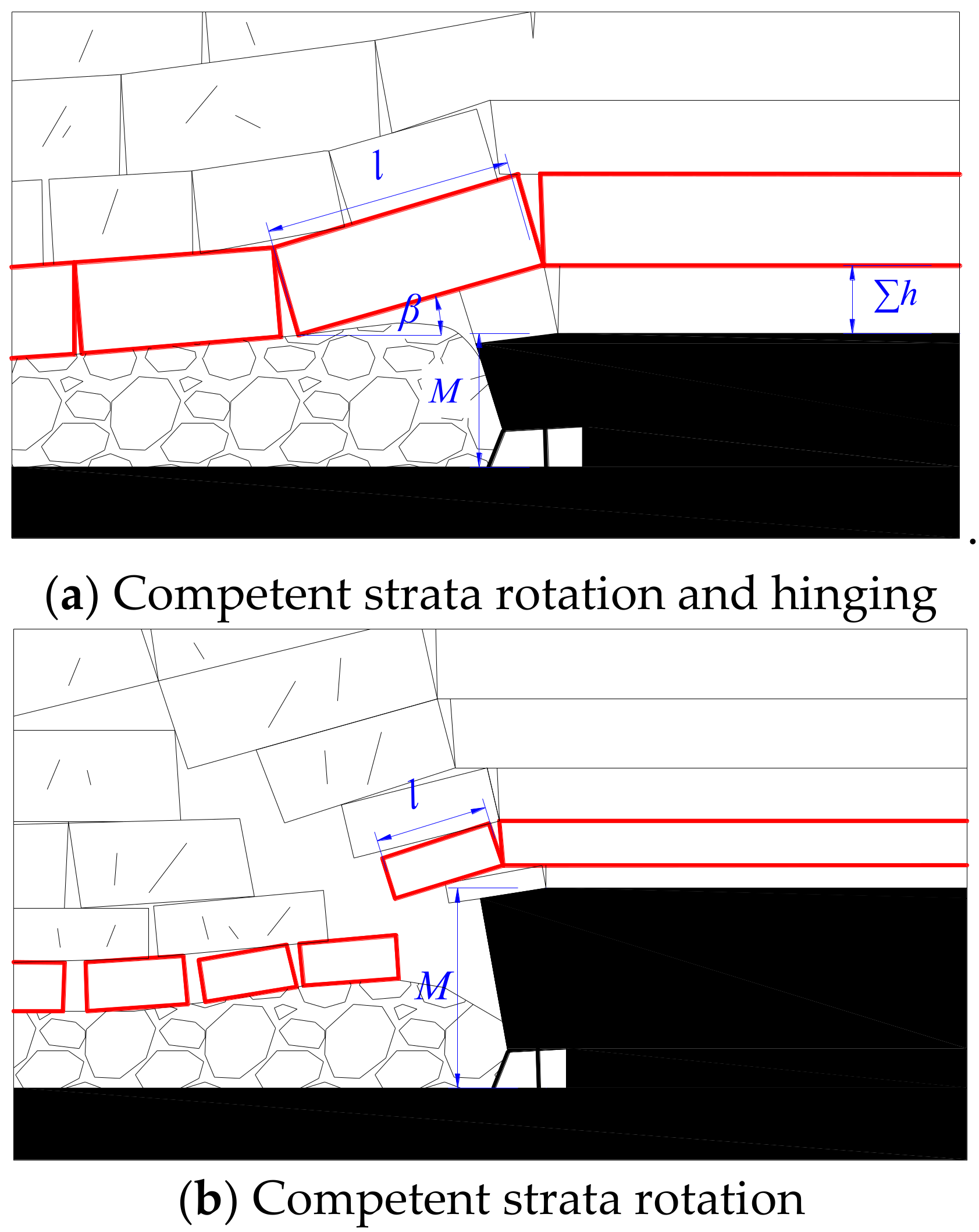


| Item | Volumetric Weight/kN·m−3 | Tensile Strength/MPa | Compressive Strength/MPa | Internal Friction Angle/° | Cohesion/MPa | |
|---|---|---|---|---|---|---|
 | fine sandstone | 2.19 | 0.95 | 17.46 | 36.44 | 1.81 |
 | gritstone | 2.10 | 0.81 | 14.14 | 39.21 | 1.13 |
 | siltstone | 2.22 | 1.02 | 17.58 | 37.91 | 1.76 |
 | coal | 1.21 | 0.67 | 6.38 | 39.86 | 0.8 |
 | mudstone | 2.28 | 0.70 | 14.21 | 37.73 | 1.41 |
 | medium sandstone | 2.08 | 0.83 | 11.12 | 39.14 | 1.06 |
| b | b ≥ 15.5 (∑M ≤ 20 m and H = 310m) | 7.75 ≤ b < 15.5 (20 m < ∑M ≤ 40 m and H = 310 m) | b < 7.75 (40 m < ∑M and H = 310 m) |
| Overburden |  | 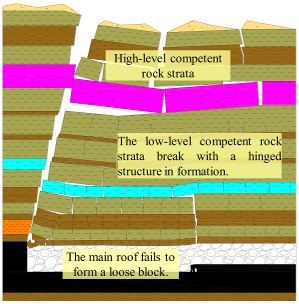 | 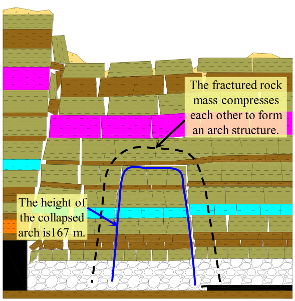 |
| Note | Overall extracted height 20 m, beam structure | Overall extracted height 40 m, higher beam structure | Overall extracted height 70 m, arch structure |
© 2019 by the authors. Licensee MDPI, Basel, Switzerland. This article is an open access article distributed under the terms and conditions of the Creative Commons Attribution (CC BY) license (http://creativecommons.org/licenses/by/4.0/).
Share and Cite
Wang, X.; Qin, D.; Zhang, D.; Guan, W.; Xu, M.; Wang, X.; Zhang, C. Evolution Characteristics of Overburden Strata Structure for Ultra-Thick Coal Seam Multi-Layer Mining in Xinjiang East Junggar Basin. Energies 2019, 12, 332. https://doi.org/10.3390/en12020332
Wang X, Qin D, Zhang D, Guan W, Xu M, Wang X, Zhang C. Evolution Characteristics of Overburden Strata Structure for Ultra-Thick Coal Seam Multi-Layer Mining in Xinjiang East Junggar Basin. Energies. 2019; 12(2):332. https://doi.org/10.3390/en12020332
Chicago/Turabian StyleWang, Xufeng, Dongdong Qin, Dongsheng Zhang, Weiming Guan, Mengtang Xu, Xuanlin Wang, and Chengguo Zhang. 2019. "Evolution Characteristics of Overburden Strata Structure for Ultra-Thick Coal Seam Multi-Layer Mining in Xinjiang East Junggar Basin" Energies 12, no. 2: 332. https://doi.org/10.3390/en12020332
APA StyleWang, X., Qin, D., Zhang, D., Guan, W., Xu, M., Wang, X., & Zhang, C. (2019). Evolution Characteristics of Overburden Strata Structure for Ultra-Thick Coal Seam Multi-Layer Mining in Xinjiang East Junggar Basin. Energies, 12(2), 332. https://doi.org/10.3390/en12020332




